Portal Crane vs. Gantry Crane: 6 Key Benefits to Help You Choose the Best Option
Table of Contents
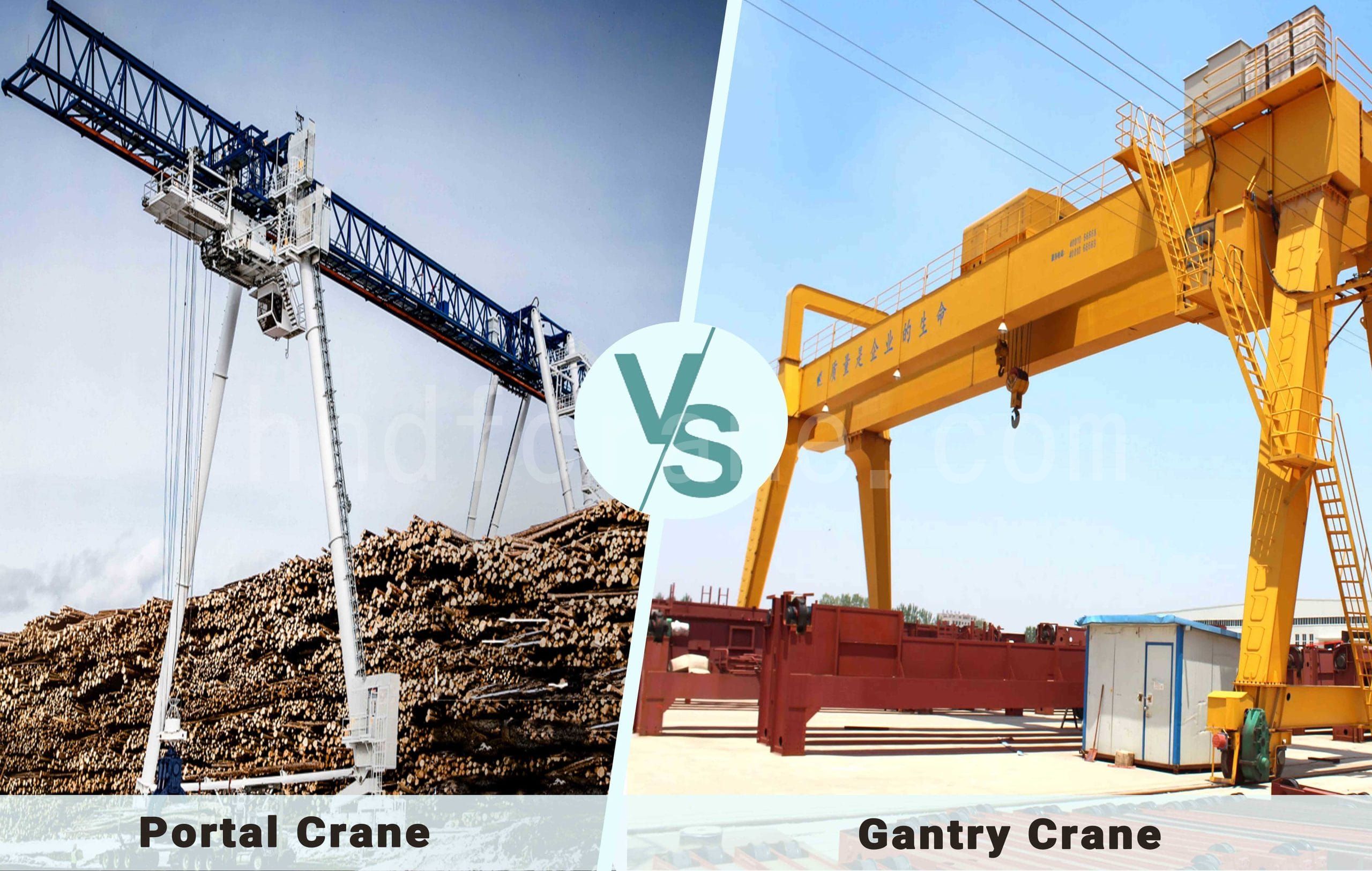
When choosing lifting equipment, it’s crucial to understand the differences between various types of cranes. Portal cranes and gantry cranes are two common types, each with unique designs and applications. But what exactly sets them apart? Which one is better suited to your needs? In this article, we will explore the features, advantages, and disadvantages of portal cranes and gantry cranes to help you make the best choice.
1.Comparison of basic information
Portal crane definition:
- Designed for the long haul,it can be rotated 360° by the orbit.
- Often used in wood yard stacking, storage yard stacking.
- The portal crane takes care of the unloading and storage of the wood, as well as the feeding of the wood, all in one unit. It can complete up to 40 pickups per hour (if travel distance is minimal). In this way, many trucks can be unloaded if necessary. You can grab a truckload of raw stakes at a time.
Portal crane applicable industry:
- For demanding applications and environments in Forest Products, Intermodal, Biomass/ Pellet, Concrete and many other industries, portal cranes need to be built tough.
Portal crane advantage:
- Safe, intelligent and efficient
- Energy is saved, power is increased, regenerative braking is used, and with every downward or decelerating motion, power is sent back to the grid instead of being dissipated by resistance. With more energy returning to the grid, less energy needs to be generated, increasing cost savings.
- The driver’s cab is ergonomic, and when workers feel comfortable, they are more likely to focus on the task at hand, reducing the risk of accidents or injuries.
- Adopt smart technology.
- Storage area increase.
- The Portal crane occupies only 4% of the yard space
- Portal crane also allows vertical storage up to 22.86m, greatly increasing the cubic storage capacity of the repository.
- The Portal crane is equipped with storm brakes and can operate in all weather conditions, even in areas with strong winds.
- Portal crane is adaptive to movement along the runway—allowing both the crane and the runway to remain in good condition for the long haul.
Gantry crane definition:
- The span is generally 35m, suitable for general use.
Gantry crane applicable industry:
- Freight yard, construction site, railway transfer station
- Shipyards and ports
- Beam factory
Gantry crane advantage:
- High utilization rate, wide use, strong adaptability, strong versatility, is the most commonly used portal lifting equipment, rated weight from 5t-500t.
- Gantry crane occupies 25% of the yard area.
Portal crane


Gantry crane


2.Classification comparison
Portal crane
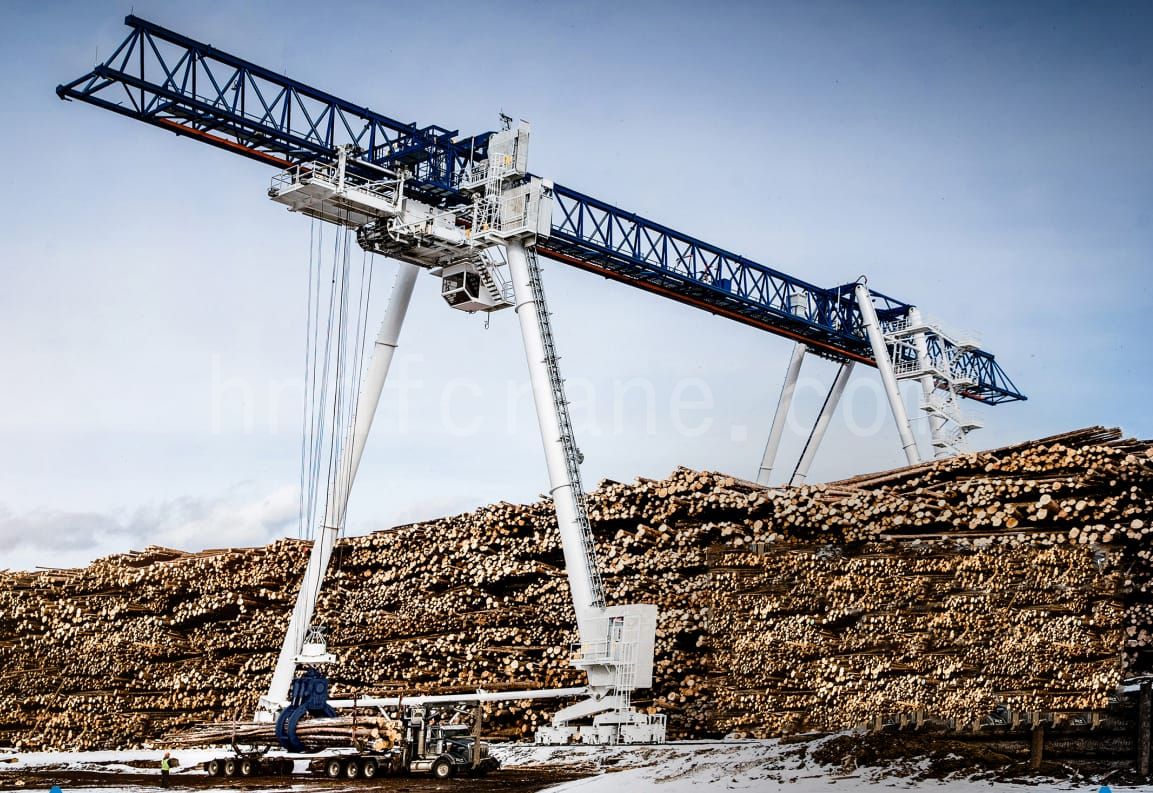
Straight Track Portal Cranes
- Most popular and optimal for future runway expansions and expanding storage space.
- Provides optimum truck traffic flow and maximum storage.
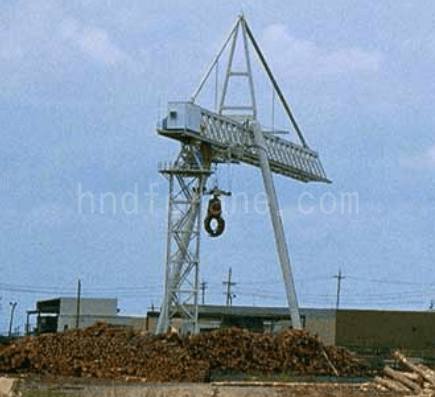
Rotating Portal Cranes
- Often fits where straight track cranes will not fit.
- Provides storage inside and outside the rail.
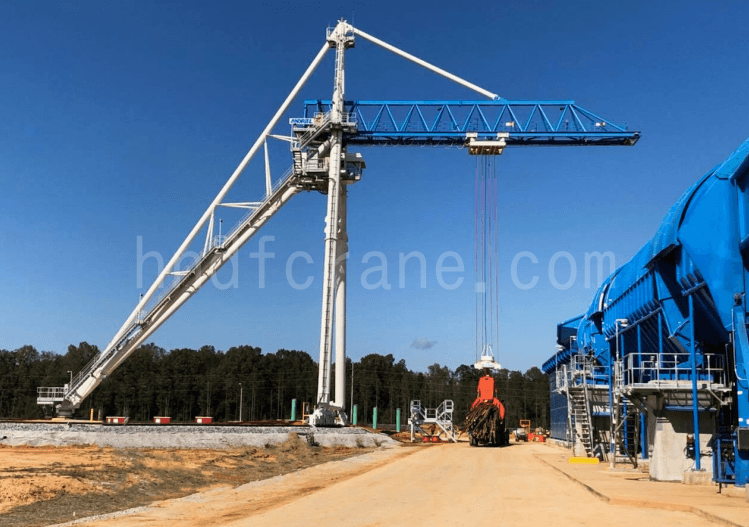
Log Boom Cranes
- The crane rotates around the bearing center support. The two large front legs move on a circular track, allowing the crane to stack the logs around for storage until the logs need to be fed into the hopper.
Gantry crane
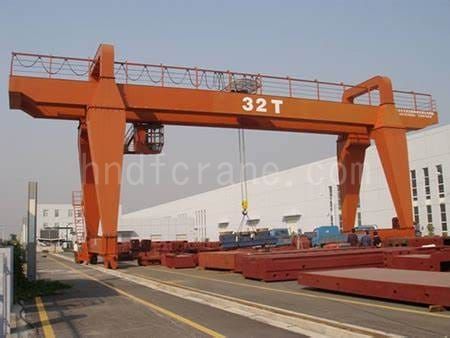
Double external cantilever frame door frame
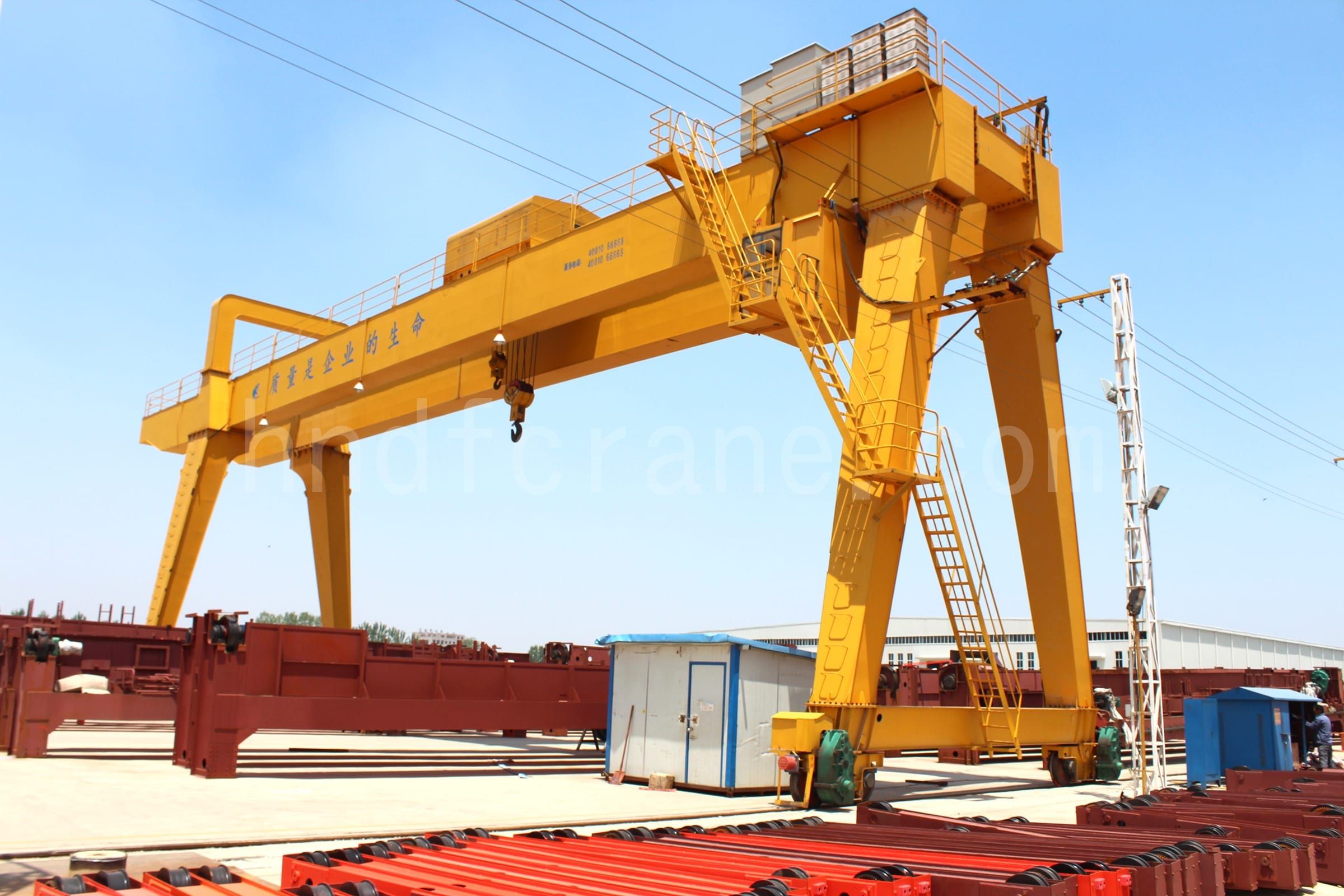
Single side door frame with outer cantilever frame
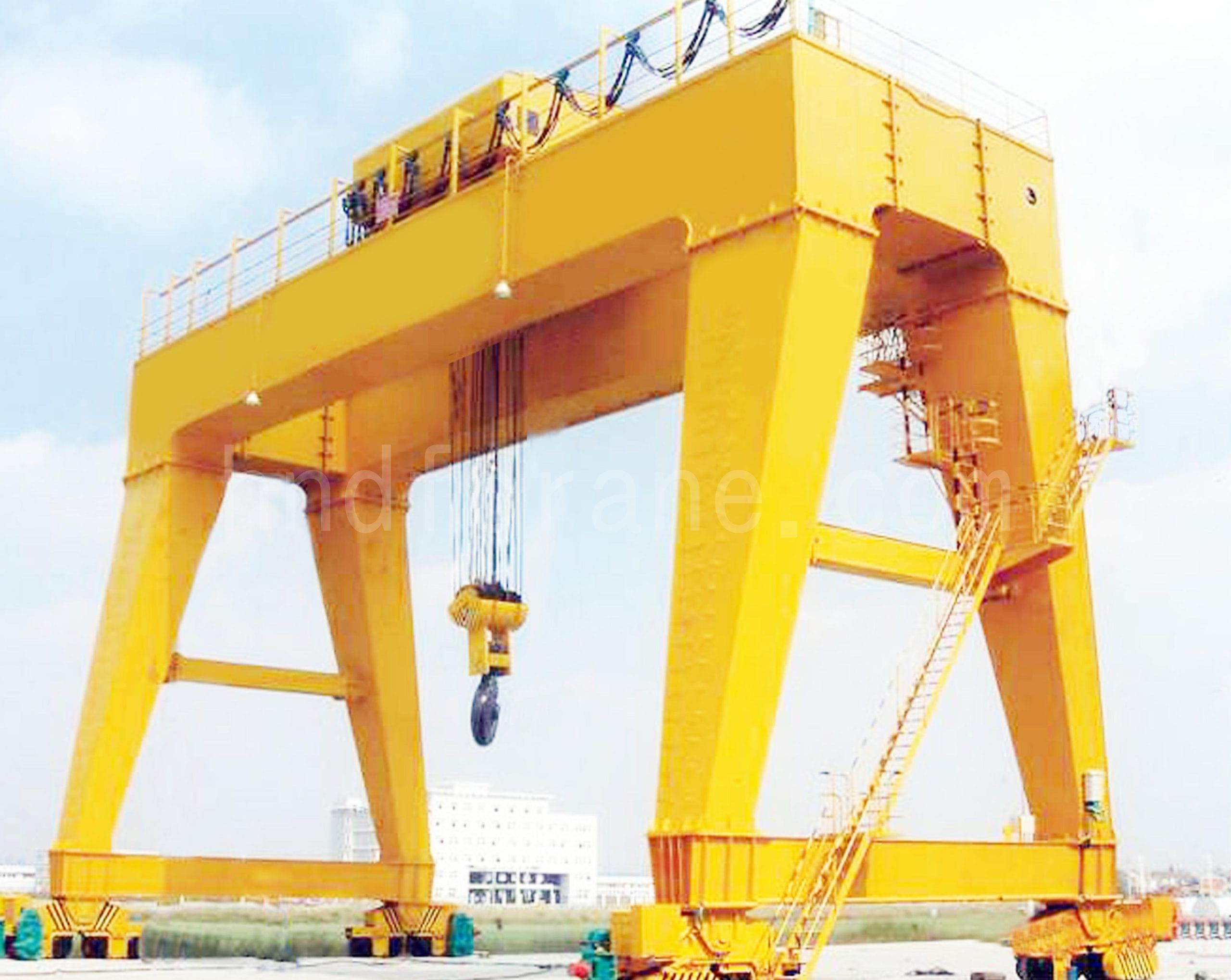
No external cantilever frame
Traditional gantry cranes is widely applicable, and there are many forms and classifications, under this category, the above three types can also be made truss gantry cranes, Dafang crane can customize the products you need one to one. You can contact us if you need anything.
3.Cost comparison
The initial investment of the Poral crane is generally lower than that of the traditional gantry crane because the portal crane is lighter and able to operate on tracks that do not require the same parallelism and straightness requirements.
The Portal crane requires only standard ground tracks laid on railroad ties on a gravel bed or simple concrete foundation. They can adapt to unstable terrain, limiting the need for expensive surface work while enabling cranes to operate at full capacity wherever tracks can be laid. This type of installation saves a lot of money compared to the deep and heavy foundation of a traditional gantry crane.
Operating cost savings, portal crane combines the unloading, transportation and stacking of materials in one efficient operation. The combination of these activities reduces equipment unit, maintenance and personnel requirements, significantly reducing operating costs compared to yards using gantry crane.
The Poral crane features energy efficient motors and controls designed for long-term reliable operation without major maintenance and associated costs.
4.The difference between box girder structures and flower stand (truss) structure
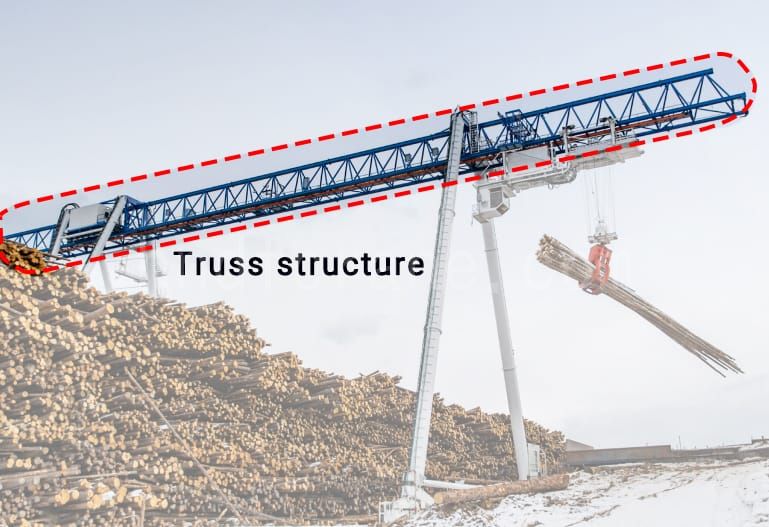
- This lattice design is cost-effective when compared to box girder structures. The open design also allows for the easy inspection of critical welds throughout the life of the crane.
- The truss beam is the main beam with the opposite material (such as channel steel, Angle steel, T-shaped steel), which can adjust the Angle and length, and is more conducive to the handling of irregular objects.
- This structure can reduce the windward area of the crane, strong wind resistance, suitable for use in windy open places.
- The open design also allows for easy inspection of critical welds throughout the crane’s service life.
- Due to the open design of the trussed main beam structure, the overhaul and maintenance are relatively simple, especially for some too small structures, which can be better observed and reduce the blind area in the maintenance process.
- The trussed main beam structure has higher freedom of leg structure, better adaptability and flexibility.
- The trussed main beam structure is more convenient to disassemble. Because of its detachable leg structure.
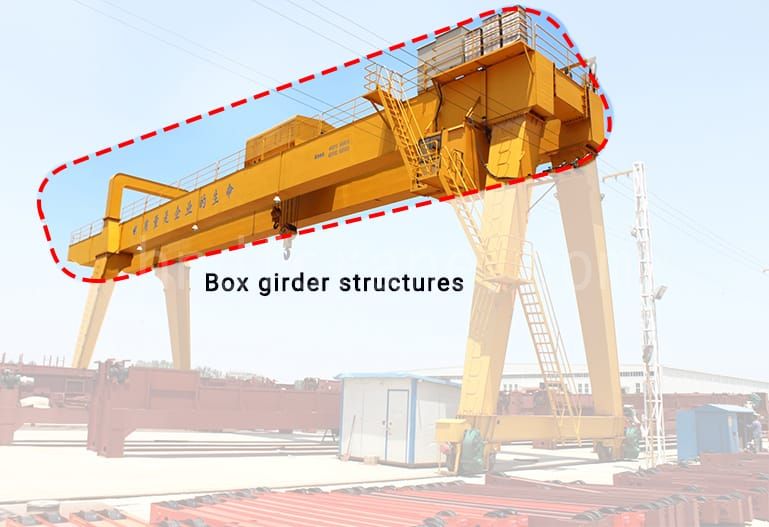
- Gantry crane with box structure has weak wind resistance, self-load and higher cost than truss type.
- Gantry crane box beam is made of steel plate welded into a box structure.
- The Gantry crane of the box-type structure is completely closed and cannot directly observe and inspect its internal mechanical structure.
- The box-type Gantry crane has good structural stability, which can better maintain the safety and reliability of equipment operation.
- The Gantry crane with box structure has a longer service life due to its good fatigue resistance.
- The Gantry crane of box-type structure should have certain hardware facilities and conditions at the site of use before it can be dismantled.
References: 大跨度门式起重机刚性支腿对结构刚度的影响分析
5.The difference between flexible legs and hinged legs
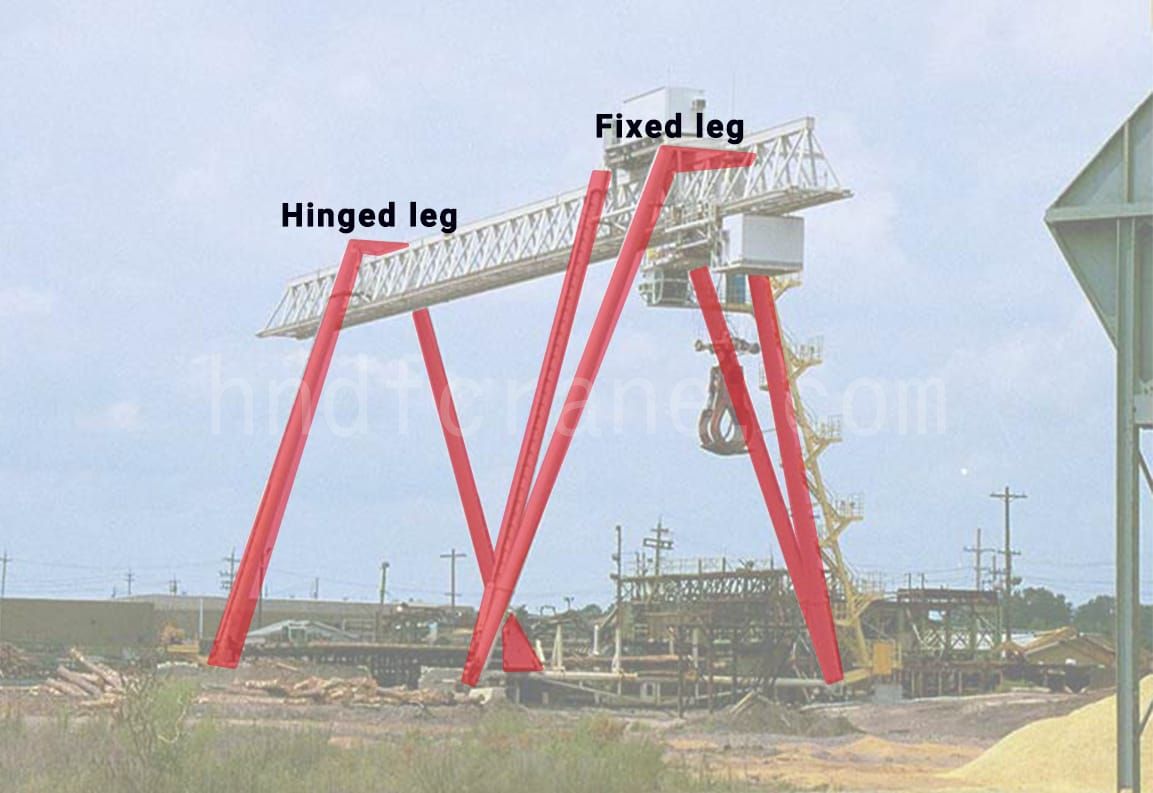
- Portal crane is designed for maximum flexibility, reducing structural and track maintenance to a minimum. The portal crane is designed for maximum flexibility which reduces structural and track maintenance to a minimum.
- The flexible legs have a certain degree of freedom and are hinged when connected with the main beam.
- The flexible legs are welded with two equal wall thickness steel pipes, and the bottom is connected with the lower beam in a triangular structure with good stability.
- Because the flexible legs can be moved along the ring track of the crane, it is suitable for some places where the crane is required to perform curved work.
- It is more inclusive to the foundation and can be applied to uneven ground.
- Flexible legs are also suitable for operations that require the crane to approach or traverse other structures.
- Weak carrying capacity.
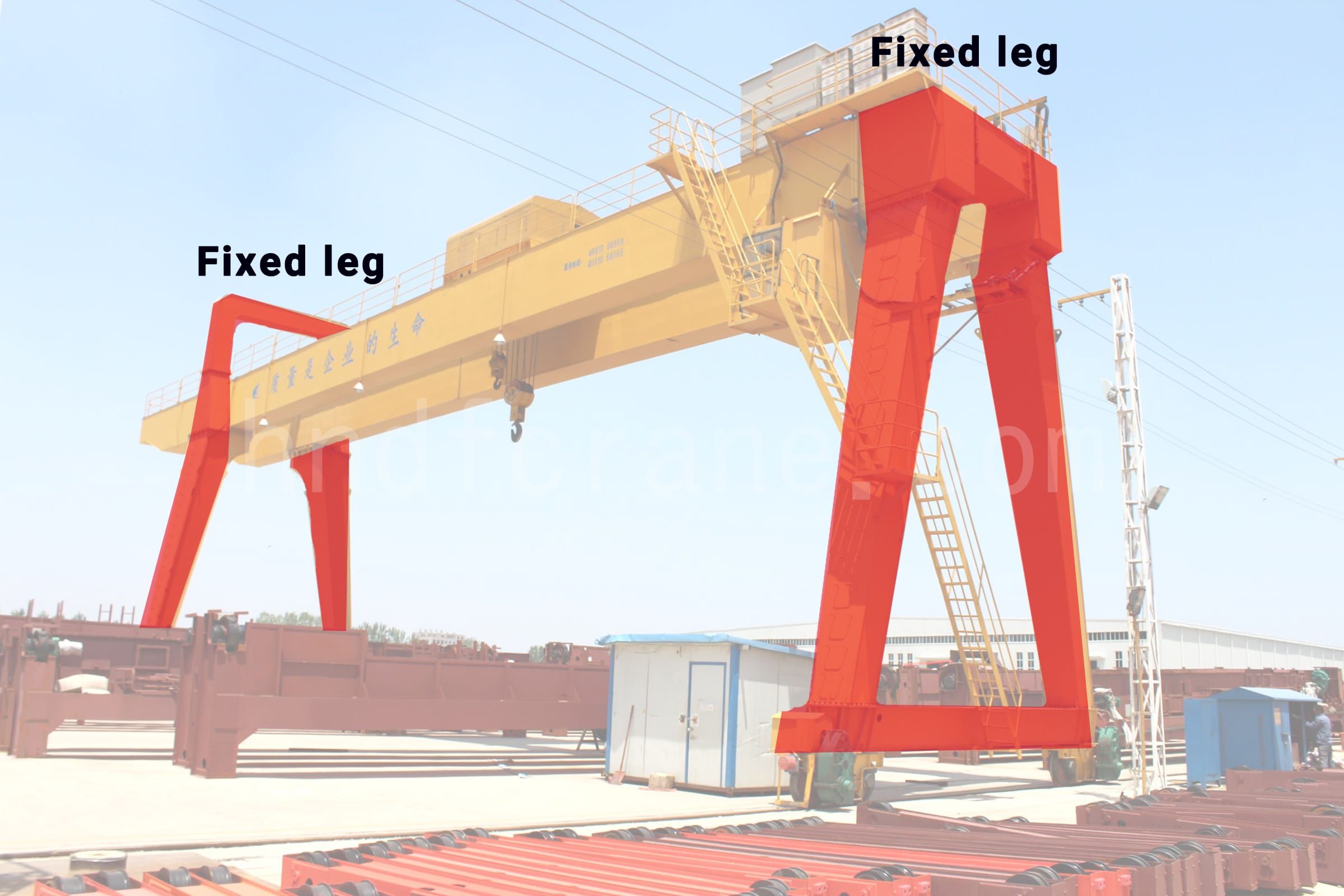
- The rigid legs are bolted when connected to the main beam, so the degree of freedom is fully restricted
- The rigid leg is also a box-type structure, and its cross-section size decreases from top to bottom.
- Due to the strong bearing capacity and stability of the rigid leg, it is suitable for some places where the crane is required to carry out high-load and high-precision operations.
- The rigid legs carry a lot of crane equipment, such as electrical control rooms, resistors, etc. In order to facilitate the staff to reach the driver’s cab or the main beam, an escalator is installed between the two rigid legs.
- Rigid legs are also suitable for a wide range of operations, such as mining and handling in open pit mines, large storage yards, etc.
- High maintenance costs and high requirements for the foundation
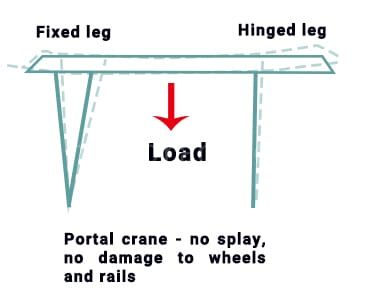
- Portal crane adopts a rigid and flexible leg design. This rigid and flexible design enables the legs to rotate freely relative to the main beam, which can reduce the phenomenon of stress concentration caused by the portal crane’s deflection operation or the main beam’s thermal expansion
- Portal crane on both sides usually adopts the form of one rigid leg and one flexible leg. One leg of portal crane is hinged with the bridge, so that the whole gantry is a statically determinate system, which eliminates the lateral thrust of the wagon to the track caused by the lifting load. At the same time, the stress state of the statically determinate gantry system is relatively clear when the wagon runs askew.
- However, this type of structure has low structural stiffness, poor dynamic characteristics, large lateral displacement generated by the main beam during lifting, and insufficient vertical horizontal dynamic stiffness.

- The fully-loaded trolley of Gantry crane is located in the center of the main beam. Due to the unsynchronization of the trolley under the legs on both sides, the gantry frame will be twisted, and serious accidents will occur, resulting in disastrous consequences.
- Rigid structures, such as box girder gantry cranes, are extremely sensitive to side-loading caused by leg-splay deflection, which leads to wheel flange wear and eventual track replacement.
- Gantry crane adopts a double-rigid leg structure with high stiffness and good dynamic characteristics. However, due to its statically indefinite structure, the lower part of the leg will offset outwards when bearing the lifting load. If the offset exceeds the gap between the wheel and the track (under normal circumstances: The gap between the wheel and the track does not exceed 15mm, the crane will not occur dangerous problems), then the truck will produce a large lateral thrust on the track, the force is unfavorable to the operation of the truck, and will cause the phenomenon of gnawing the rail. At the same time, there are higher requirements for the fixing of the rail, especially when the span is large, even the no-load state will also appear rail gnawing phenomenon.
6.Crane base comparison
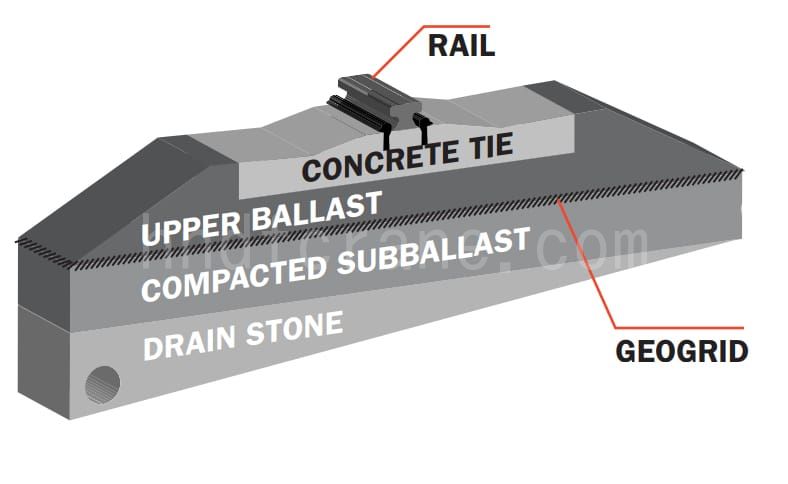
- The image shows a cross-sectional diagram of a “tie and ballast” style runway foundation, which is used to support crane. The foundation is built with multiple layers, each serving a distinct purpose to ensure stability, durability, and proper drainage. Here’s a breakdown of the layers from the bottom to the top:
- Drain Stone: This is the bottom-most layer, consisting of stones designed to provide proper drainage. This layer ensures that water does not accumulate under the foundation, which could otherwise lead to weakening or erosion.
- Compacted Subballast: Above the drain stone layer is the compacted subballast. This layer is typically made of finer materials and is compacted to provide a stable base for the upper layers. It helps distribute the load from the above layers more evenly and adds additional drainage capability.
- Geogrid: A geogrid is placed above the compacted subballast. Geogrids are geosynthetic materials used to reinforce the soil, providing additional stability and strength to the foundation. They prevent the movement of the subballast and increase the overall load-bearing capacity of the foundation.
- Upper Ballast: This layer consists of larger stones or ballast that provide a solid base for the concrete ties. The ballast is crucial for distributing loads from the rails and ties and for maintaining track alignment by resisting lateral, longitudinal, and vertical forces.
- Concrete Tie: Concrete ties (or sleepers) are placed on top of the upper ballast layer. These ties are critical components that hold the rails in place, maintaining the gauge and alignment of the tracks.
- Rail: Finally, the rail is laid on top of the concrete ties. The rails are the tracks on which the cranes move. They are fastened to the concrete ties using clips or other fasteners to keep them securely in place.
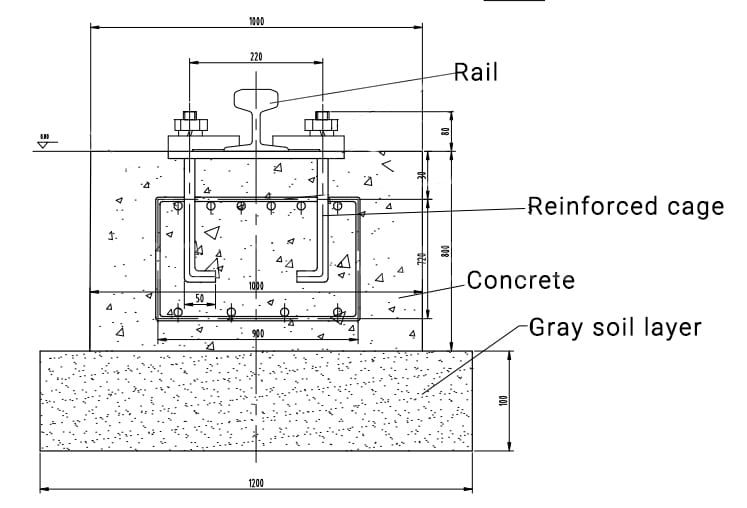
- The image provided shows a technical drawing of a foundation design for a railway track system. It details the cross-section of the foundation, highlighting the layers and components used in its construction. Here is a breakdown of the elements shown in the drawing:
- Rail:This is the topmost component of the foundation. The rail is the metal track on which trains or cranes move. It is typically made of high-strength steel and is secured to the concrete foundation using bolts and fasteners. The rail shown is mounted directly onto the concrete surface.
- Reinforced Cage:Beneath the rail, embedded within the concrete, is a reinforced steel cage. This cage is composed of steel rebar arranged in a grid-like pattern, providing tensile strength and enhancing the overall structural integrity of the concrete. The reinforced cage prevents cracking and distributes loads more evenly throughout the concrete.
- Concrete:The concrete layer forms the main body of the foundation. It is a solid, reinforced block that supports the rail and absorbs the loads transferred from the rail. The concrete is poured over the reinforced steel cage and is designed to bear substantial compressive forces. The drawing indicates a thickness of 900 mm for the concrete foundation, providing substantial stability and support.
- Gray Soil Layer:The gray soil layer is the base on which the entire foundation rests. This layer is likely composed of compacted soil or a prepared subgrade that provides a stable base for the concrete foundation. The drawing shows this layer to have a thickness of 100 mm, indicating that it is well-compacted and serves as a base to distribute the load from the concrete foundation.
The Portal crane requires only standard ground tracks laid on railroad ties on a gravel bed or simple concrete foundation. They can adapt to unstable terrain, limiting the need for expensive surface work while enabling cranes to operate at full capacity wherever tracks can be laid. This type of installation offers significant savings compared to the structural steel structure of Gantry crane or the deep and heavy foundation of a traditional gantry crane.
In summary
When you consider yard size savings, reduced manpower, faster truck turn arounds, fewer pieces of equipment, reduced maintenance, elimination of fuel oil use and ground contamination, the Portal Crane is the SMART way to go.
In summary, by in-depth understanding of the differences between portal crane and gantry crane in five aspects: classification, cost, box type and truss, rigid leg and flexible leg, and foundation, we can better evaluate their advantages in different application scenarios. The Portal crane, with its high flexibility and adaptability, is suitable for use in environments where space is limited or diverse handling is required, while the gantry crane, with its superior load carrying capacity and versatility, is ideal for heavy lifting tasks. When making your final decision, you can choose the lifting equipment that is best for you based on your specific operational needs, budget, and site conditions.
Whether you are looking for precise control and versatility, or stability and cost effectiveness, Dafang crane’s team of experts can provide you with personalized advice and solutions to ensure you maximize the return on your investment. Contact us and let us help you find the perfect crane solution to improve your operational efficiency!
Send Your Inquiry
- Email: sales@hndfcrane.com
- WhatsApp: +86-191 3738 6654
- Tel: +86-373-581 8299
- Fax: +86-373-215 7000
- Add: Changnao Industrial District, Xinxiang City, Henan Province, China










































































